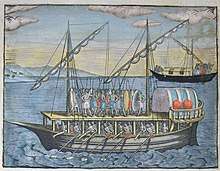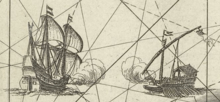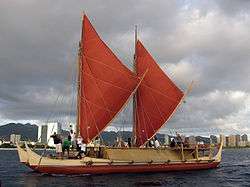Ghali (ship)
Ghali, gali or gale refers to several types of galley-like ships from Nusantara archipelago. In the archipelago, already existed several native galley-like ships, some with outriggers. A ghali (or its similar terms) is the result of mediterranean impact of native shipbuilding, particularly introduced by the Arabs, Persians, Ottoman Turks, and Portuguese. However the terms may refer to Mediterranean vessels built by local people, or native vessels with Mediterranean influence.[1]
Etymology
The word ghali and its variation comes from the Portuguese word galé, which means galley.[2] The reason of addition of the letter h is because it is written in Malay texts using jawi script, with an initial ghain (غ) as in ghurab.[1]
History and description
There are several type of vessels using similar names in the archipelago, the description and construction of each vessel isn't necessarily the same.
Malacca
A royal galley (ghali kenaikan raja) of the Malacca sultanate that was built approximately in 1453 is called Mendam Berahi (Malay for "Suppressed Passion"). It was 60 gaz (54.6 m) long and 6 depa (11 m) wide. This ghali had 3 masts and could carry 400 men; 200 of them were rowers in 50 rowing line.[1] It was armed with 7 bow-mounted meriam (native cannon) and ramming beam.[3][4]
Eastern Indonesia

In eastern Indonesia, a type of vessel called galé (lit. galley) adapted by the Spanish and the Portuguese for use in the Philippines and eastern Indonesia. It was long and narrow, the vessel narrowed considerably fore and aft. The length is 7 or 8 times its breadth. It had a deck running the whole length of the boat and was propelled by long oars. A special deck was built for the fighting men, and along the whole length of the galley were placed shields to protect the rowers and the soldiers.[5]
Aceh

The Sultanate of Aceh is famous for the use of Ottoman-derived galleys. It is interesting that the Aceh's term for galley is ghali, which is derived from the Portuguese word galé, not from Turkish term for it (Kadırga).[1] Acehnese in 1568 siege of Portuguese Malacca used 4 large galley 40–50 meter long each with 190 rowers in 24 banks. They were armed with 12 large camelos (3 at each bow side, 4 at stern), 1 basilisk (bow-mounted), 12 falcons, and 40 swivel guns.[6] By then cannons, firearms, and other war material had come annually from Jeddah, and the Turks also sent military experts, masters of galleys, and technicians.[7] The average Acehnese galley in the second half of the 16th century would have been approximately 50 metres long, had two masts, with square sails and top sails, not lateen sails like those of Portuguese galleys.[8] It would have been propelled by 24 oars on each side, carrying about 200 men aboard, and armed with 20 cannons (two or three large ones at the bow, the rest smaller swivel guns).[9]
In 1575 siege, Aceh used 40 two-masted galleys with Turkish captains carrying 200–300 soldier of Turk, Arab, Deccanis, and Aceh origins. The state galleys (ghorab istana) of Aceh, Daya, and Pedir is said to carry 10 meriam, 50 lela, and 120 cecorong (not counting the ispinggar). Smaller galley carry 5 meriam, 20 lela, and 50 cecorong.[10] Western and native sources mention that Aceh had 100–120 galleys at any time (not counting the smaller fusta and galiot), spread from Daya (west coast) to Pedir (east coast). One galley captured by Portuguese in 1629 during Iskandar Muda's reign is very large, and it was reported there were total 47 of them. She reached 100 m in length and 17 m in breadth, had 3 masts with square sails and topsails, propelled by 35 oars on each side and able to carry 700 men. It is armed with 98 guns: 18 large cannon (five 55-pounders at the bow, one 25-pounder at the stern, the rest were 17 and 18-pounders), 80 falcons, and many swivel guns. The ship is called "Espanto do Mundo" (terror of the universe), which probably a free translation from Cakradonya (Cakra Dunia). The Portuguese reported that it was bigger than anything ever built in the Christian world, and that its castle could compete with that of galleons.[9]
Java
Two Dutch engravings from 1598 and 1601 depicted galley from Banten and Madura. They had 2 and 1 mast(s), respectively. The major difference from mediterranean galleys, this galley had raised fighting platform called "balai" in which the soldier stood, a feature common in warships of the region.[11] Javanese galleys and galley-like vessels are built according to instruction from Turks living in Banten.[12]
Sulawesi
The Sultanate of Gowa of the mid-17th century had galle' (or galé) 40 m long and 6 m breadth, carrying 200–400 men. Other galle' of the kingdom varied between 23–35 m in length.[13][14] Those ships were used by Gowa's king to perform inter-island sea voyages and trades in Nusantara, either in the western (Malacca, Riau, Mempawah, Kalimantan) or in the eastern (Banda, Timor, Flores, Bima, Ternate, and North Australia).[15]
Karaeng Matoaja, government director of Gowa and prince of Tallo, among other things, had nine galleys, which he had built in the year in which Buton was conquered (1626). The ships are called galé. Their dimensions are 20 depah (36.6 m) long and 3 depah (5.5 m) wide. They had three rudders: Two Indonesian rudders on either side of the stern, and a European axial rudder. It is not strange that Makassar had galleys in the 17th century. Gowa has maintained friendly relations with the Portuguese since 1528.[12]
This kind of ships is usually owned by the rich people and kings of Bugis and Makassar. For inter-island trading, Makassarean gale ships were considered as the most powerful ship, and therefore used by Bugis-Makassar and Malayan noblemen to transport spices from Moluccas. The usage of gale improved the maritime trading in Gowa, as well as other ports in South Sulawesi, since 16th century.[16][13]
See also
References
- Reid, Anthony (2012). Anthony Reid and the Study of the Southeast Asian Past. Singapore: Institute of Southeast Asian Studies. ISBN 978-9814311960.
- "English Translation of "galé" | Collins Portuguese-English Dictionary". www.collinsdictionary.com. Retrieved 2020-01-30.
- Nugroho, Irawan Djoko (2011). Majapahit Peradaban Maritim. Suluh Nuswantara Bakti. ISBN 9786029346008.
- Salleh, Muhammad Haji (2010). The Epic of Hang Tuah. ITBM. ISBN 9789830687100.
- Tarling, Nicholas (1999). The Cambridge History of Southeast Asia. Cambridge: Cambridge University Press. ISBN 9780521663700.
- Manguin, Pierre-Yves (1988). "Of Fortresses and Galleys: The 1568 Acehnese Siege of Melaka, after a Contemporary Bird's-Eye View". Modern Asian Studies. 22.
- Boxer. The Acehnese attack on Malacca in 1629. pp. 119–121.
- Augustin de Beaulieu, Mémoire d'un voyage aux Indes orientale (1619-1622). Un marchand normand à Sumatra, édité par Denys Lombard, Pérégrinations asiatiques I (Paris: École française d'Extrême-Orient, 1996).
- Reid, Anthony (2012). Anthony Reid and the Study of the Southeast Asian Past. Institute of Southeast Asian Studies. ISBN 978-981-4311-96-0.
- Iskandar, Teuku (1958). De Hikajat Atjeh. Gravenhage: KITLV. p. 175.
- Lode (1601). Tweede Boek. Amsterdam. p. 17.
- Noteboom, Christiaan (1952). "Galeien in Azië". Bijdragen tot de Taal-, Land- en Volkenkunde. 108: 365–380.
- Hadrawi, Muhlis (May 2018). "Sea Voyages and Occupancies of Malayan Peoples at the West Coast of South Sulawesi". International Journal of Malay-Nusantara Studies. 1: 80–95.
- Sidiq H. M., Muhammad (21 June 2019). "Kapal-Kapal di Wilayah Kesultanan Gowa Abad 17 M". IslamToday. Retrieved 23 January 2019.
- Chambert-Loir, Henri. 2011. Sultan, Pahlawan dan Hakim, Lima Teks Indonesia Lama. Naskah dan Dokumen Lama Seri XXIX. Jakarta: KPG, Ecole Francaise d’Extreme-Orient, MANASSA, Pusat Kajian Islam dan Masyarakat-UIN Jakarta.
- Pelras, Christian (1996). The Bugis. Oxford: Blackwell Publisers Ltd.




.jpg)